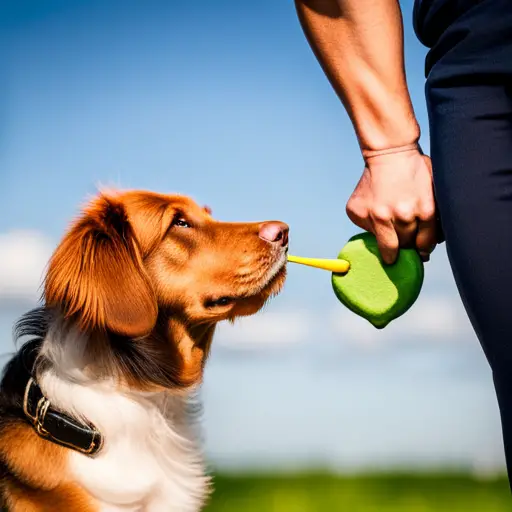Did you know that over 63 million households in the United States have at least one dog? That means millions of people are looking for ways to train and teach their furry friends basic commands.
If you’re one of those people, you’ve come to the right place. Teaching your dog basic commands not only makes your life easier but also strengthens the bond between you and your pet.
In this article, you’ll learn the essential steps to teach your dog basic commands. From simple commands like ‘sit’and ‘stay’to more complex ones like ‘heel’and ‘roll over,’we’ll cover everything you need to know.
With a little bit of patience, consistency, and practice, you’ll soon have a well-behaved dog that can impress your friends and family.
So, let’s get started!
Key Takeaways
– Teaching basic commands can strengthen the bond between owner and pet, and improve overall behavior.
– Positive reinforcement is the preferred method for teaching commands, while punishment can create fear and anxiety in dogs.
– Consistency, patience, and practice are key to successful training, and establishing a routine can help with this.
– Correcting mistakes should be done without punishment, and redirection can be an effective technique.
Start with Simple Commands

Start with simple commands.
Begin by showing your furry friend how to sit and stay still, using treats as a reward for good behavior. Using positive reinforcement is the best way to teach your dog basic commands as it encourages them to learn and improve. Avoid punishment as it can create fear and anxiety in your dog, hindering their progress in learning new commands.
To teach your dog to sit, hold a treat above their head and move it towards their tail. This will cause them to lower their hindquarters and sit. Once they are in a sitting position, give them the treat and praise them. Repeat this process until they sit on command without the use of treats.
Once they have mastered the ‘sit’ command, move on to more complex commands, such as ‘stay’ and ‘come’.
Move on to More Complex Commands

Now that your dog has mastered basic commands, it’s time to move on to more complex ones. To start, focus on teaching your dog the ‘Heel’ and ‘Come’ commands.
Be sure to use consistency and patience when teaching these new skills. With persistence and practice, your furry friend will soon be a well-trained and obedient companion.
Teach ‘Heel’ and ‘Come’
To get your furry friend walking by your side and coming when called, try teaching them the commands ‘Heel’ and ‘Come’ with positive reinforcement techniques.
Leash training is a great way to teach your dog to walk by your side, and is a necessary step in teaching the ‘Heel’ command. Start by attaching a leash to your dog’s collar and holding it firmly, then begin walking. If your dog pulls or wanders off, stop walking and wait for them to come back to your side. When they do, reward them with a treat and praise. Repeat this process until your dog learns to walk calmly by your side.
Next, move on to teaching the ‘Come’ command. This command is important for keeping your dog safe, as it ensures that they come to you when called in any situation. Start by standing a few feet away from your dog and calling their name, then say ‘Come’ in a happy tone of voice. When your dog comes to you, reward them with a treat and praise.
Gradually increase the distance between you and your dog, and practice in different environments to ensure that they understand the command. Remember to always use positive reinforcement and consistency when teaching your dog new commands. With patience and practice, your furry friend will be walking by your side and coming when called in no time!
Use Consistency and Patience
If you want to see progress in your furry friend’s behavior, consistency and patience are key. Dogs are intelligent creatures, but they need repetition and reinforcement to learn new commands.
Make sure you’re using the same words and gestures every time you give a command. If you use different words or gestures, your dog may become confused and not understand what you want them to do.
Reinforce positive behavior by rewarding your dog with treats, praise, or playtime. Avoid punishing your dog for not understanding a command or making a mistake. Punishment can be harmful to your dog’s mental and emotional well-being and can lead to fear, anxiety, and aggression.
Remember, teaching your dog basic commands takes time and effort, but the bond you’ll create with your furry friend will be worth it.
Now, let’s move on to the next section about the importance of practice in teaching your dog new commands.
Practice, Practice, Practice

As you work on teaching your dog basic commands, remember that consistent practice is key to their success, so make sure to set aside time each day for training sessions. Use repetition techniques and positive reinforcement strategies to help your dog understand and remember the commands.
Below are some tips to help you make the most of your training sessions:
– Break up training sessions into shorter periods of time to keep your dog engaged and focused.
– For example, instead of one long 30-minute session, try three 10-minute sessions throughout the day.
– Use treats or praise to reward your dog for following commands correctly.
– Make sure to give the reward immediately after the command is followed to reinforce the behavior.
With consistent practice and positive reinforcement, your dog will start to understand and follow basic commands. However, if you encounter problem behaviors, address them promptly to prevent them from becoming ingrained habits.
Now, let’s move on to the next section and learn how to address problem behaviors.
Address Problem Behaviors

Now it’s time to tackle any misbehaviors and ensure your furry friend is on their best behavior. Correcting jumping behavior is one of the most important things you can do to ensure your dog is well-behaved and doesn’t cause any harm to themselves or others.
When your dog jumps up on you or others, it’s important to immediately correct this behavior. You can do this by using a firm voice command like ‘off’ or ‘down’ and then rewarding your dog with a treat when they comply. This positive reinforcement will help your dog learn that jumping is not acceptable.
Another problem behavior that many dogs exhibit is excessive barking. This can be a nuisance for both you and your neighbors. To address this behavior, first try to identify the cause of the barking. Is your dog barking because they are bored, anxious, or scared?
Once you know the cause, you can work on correcting the behavior. You can do this by giving your dog plenty of exercise and mental stimulation, using a firm voice command like ‘quiet’ or ‘enough’, and rewarding them with treats when they comply. Remember to always be consistent with your commands and rewards to help your dog learn what is expected of them.
By addressing problem behaviors like jumping and excessive barking, you can help your dog become a well-behaved and obedient companion. But your work doesn’t end there. To maintain consistency and reinforcement, you need to establish a routine and continue to practice basic commands with your dog regularly.
Maintain Consistency and Reinforcement

To truly instill good behavior in your furry friend, it’s important that you consistently reinforce the positive habits they’ve learned and establish a routine that fits both your lifestyles.
This means you should praise and reward your dog when they follow your commands and exhibit good behavior. Whether it’s giving them a treat or a belly rub, make sure your dog knows that they’re doing a good job.
On the other hand, it’s equally important that you correct your dog’s mistakes when they happen. This doesn’t mean punishing them, but rather redirecting their behavior and showing them the correct way to behave.
For example, if your dog jumps on guests when they come over, calmly tell them ‘off’ and redirect their attention to a toy or treat.
With consistent reinforcement and correction, your dog will learn what behavior is expected of them and become a well-behaved companion.
Conclusion
Congratulations! You’ve successfully trained your dog to follow basic commands. Now, it’s time to move on to more complex ones. This will require patience and dedication, but the end result will be worth it.
As you continue to practice with your furry friend, don’t forget to address any problem behaviors that may arise. By consistently reinforcing positive behaviors and redirecting negative ones, you’ll be able to help your dog become a well-behaved member of your family.
So, keep up the hard work and enjoy the rewards of having a happy, obedient pup by your side. Remember, a well-trained dog is a happy dog!
